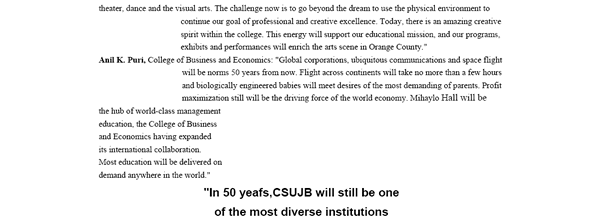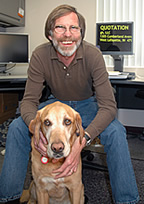Inclusion Focus of Campus Efforts
Cal State Fullerton Delves Into Efforts to Bring Better Accessibility to Campus Technology
Oct. 16, 2007
by Pamela McLaren
When Jeff Senge, coordinator of the Information and Computer Access Program in the Office of Disabled Student Services, was going to graduate school and “reading” his textbooks, he did so through his computer, by using a digital text reader and an optical scanner. People with visual impairments and students with other types of print disabilities are using these same methods today to keep up with daily news and their studies.
But the material is not always easy to read. Photos, charts and maps, poetry and other non-textual or heavily structured items frequently need additional editing or translation to make them understandable to those with learning and visual disabilities when presented in an electronic text, or etext, format.
Imagine having a computer-based reading system, which only recognizes text, trying to make sense of a chart without embedded information that describes what it is, such as “this is a chart of the number of men, women and children who use product X by month”?
Today’s optical character recognition systems can read text upside down and place it correctly for the reader on the screen, explains Senge, but when there is text going in several directions on the same page, the scanner has a challenging time of trying to figure out what to do with it.
Even the simple translation of a newspaper article is enhanced if embedded into the digital text is a structural mark-up that provides an explanation of what is being read by the computer-based technology to the print disabled person, such as “Headline – Man Bites Dog, byline – John Jones of Associated Press, indent paragraph – Neighbors were surprised today when….”
What is needed, Senge says, is “the consistent application of established structural mark-up standards to digital publications.”
When structural mark-up tags are included in digital publications, specialized computer-based technologies used by people with print disabilities can effectively render the digital text into alternate formats, such as audio and Braille, without loss of content and structural value. Thus providing immediate access to written information with a greater level of understanding to those with print disabilities.
To do just that, Cal State Fullerton is joining a California State University systemwide effort to make technology and information more accessible.
When digital content is created, it also needs to include alternate descriptions for graphical content. There needs to be textual descriptions that clarify what information is being conveyed through charts, figures, photographs, etc. It can be done with text tags or in some instances textual balloons embedded into the digital copy to provide detail that makes such material more understandable, says Senge. An example is a tag imbedded into the digital copy so that when a computer-based reading system or Braille translation software program runs across a photo, it reads a description, such as “photo of three soldiers signing treaty with….”
“We’ve been very proactive during the last five-six years to make websites accessible,” says Amir Dabirian, director of information technology. Many university pages have the capacity for computer-based readers for the blind to read what is on the page, but more is needed.
“It’s really about inclusion of people throughout our community,” says Senge. “Content presented on web pages must be accessible to all faculty, staff and students, as well as to visitors from beyond the campus.”
Since last year, campuses, including Cal State Fullerton, have been evaluating, benchmarking and making plans to bring their technological resources — including web content, instructional materials and electronic and technology products, such as phones, fax machines and computer hardware and software — into compliance with CSU Executive Order 926, which is based on the requirements of the Americans with Disabilities Act and Section 508 of the Rehabilitation Act.
This fall, campuses began implementation of campus plans with the goal of integrating accessibility at the design stage of software, web and course development, as well as in business and instruction practices. By fall 2008, new courses and content, including materials and websites, will incorporate accessibility for the disabled.
“It’s very challenging,” admits Dabirian, who remains positive of CSUF’s ability to meet the requirements. “It’s a good thing to do.”
To learn more about the university’s efforts, go to the following websites:
http://www.fullerton.edu/ati/
http://www.fullerton.edu/ati/Web/index.html
http://www.fullerton.edu/ati/Instructional/index.html
http://www.fullerton.edu/ati/E&IT/index.html
http://www.fullerton.edu/it/News/Publications/itdownload/priorities_curb_cuts.htm


